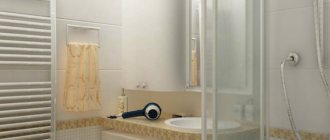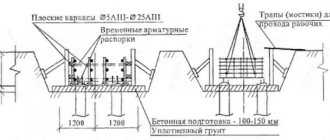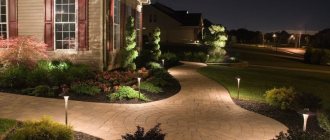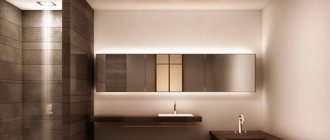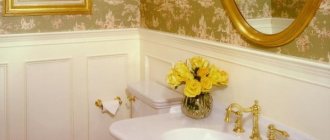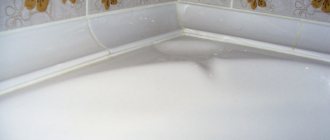Lighting system planning and design
Do not forget that the bathroom is not only intended for relaxation and relaxation, necessary after difficult and busy work days.
Here, all family members are preparing for the coming day and getting themselves in order before work or school, ladies are applying makeup or washing it off, so it is important to choose the right lighting for the ceiling in the bathroom and other surfaces.
Harmonious design involves timely and preliminary design of the decor and finishing of all surfaces, which makes the arrangement of the room as practical as possible.
Before designing a lighting system, it is necessary to carry out zoning and division of space, and consider the placement of plumbing fixtures and furniture.
How much light do you need in the bathroom?
The ideal option for a bathroom is a sufficient amount of light, close to daylight. This way you can create the most natural light possible for a natural look and makeup application. Since a combined bathroom can be used for different needs, it is better to install a combined type of lighting in it.
For a small bathroom in a Khrushchev-era building, one central light in combination with two or three additional wall lamps is appropriate.
In a large room, it is advisable to install several overhead lighting devices. The greater the number of lamps, the smaller in size and power they should differ. For a spacious bathroom, zone lighting is suitable, thanks to which it will be possible to highlight individual functional areas, as well as emphasize the configuration of the space.
The photo shows the lighting of a small bathroom in the form of a laconic central chandelier placed on the ceiling
The following important factors influence the choice of lighting:
- Interior style and color palette. The darker the shade of the walls, the greater the intensity of the light sources.
- Size and shape of the bathroom.
- Features of zoning.
- Types of lamps, their maximum power and mounting method.
- The presence of reflective surfaces in the form of mirrors, tiles, etc.
First of all, before starting renovations in a room, they think through the light system and the specific places where its sources will be placed. They provide for cable wiring, construction of plasterboard false beams and other things.
Specifics of electrical wiring in the bathroom
Deciding how to arrange the lamps in the bathroom and what lighting devices will be used in the system is necessary at the preparatory stage before the renovation. Wiring in this room is carried out in a hidden way; the following is required:
- create an accurate cable routing diagram;
- choose wires taking into account the power of all electrical appliances;
- make a secure, reliable connection.
When installing electricity in the bathroom, aluminum and copper cables with a cross section of 4 mm and 2.5 mm are used, respectively. To determine the exact size for a specific room, the total power indicator is divided by 220. However, you should not make your own choice of consumables for the lighting system. It is better to entrust this work to a specialist who will do the wiring.
Example lighting system plan
Having an accurate layout of light sources allows you to drill walls and ceilings in the right places, lay cables along optimal routes, and ensure convenient use of lamps.
Which light to choose?
Regardless of whether the bathroom is windowless or not, you should choose bright lighting that will not irritate the eyes. Warm light with a yellowish tint is considered the most comfortable and pleasant. This soft glow will promote complete relaxation in the bathing area. Devices with cool bluish light, located near the washbasin, will help you quickly wake up and invigorate.
What types of lamps are there - advantages and disadvantages
| Type of lamps | pros | Minuses |
| Incandescent lamps | Cheap. Gives soft light. Turns on quickly. | They are heating up. Not suitable for installation in suspended ceilings. They burn out quickly. Not economical. |
| Halogen | High light output. Long service life. Can be used for spotlights in suspended ceilings. Available in two versions: 220V and 12V. | Connected via stabilizer. They deteriorate from touching the skin. They are warming themselves. Often the base burns out from the light bulb. |
| Luminescent | Economical. Choice of color shades of emitted light. Two contact options - rods and base. Smooth diffused light flux. | Sensitivity to low temperature. Presence of mercury vapor in the flask. You can't break it. |
| LED | Repairable. If one diode burns out, the cluster can be repaired and the lamp will continue to work. Economical. Durable. Wide variety of colors. Possibility of programming. Not afraid of frequent switching on/off. | Expensive. Switching power supplies are required. Without them, lamps quickly fail. Instead of the stated 11 years, after 3 years the crystals lose their brightness and begin to fade. For comfortable work, diffuser shades are required. |
Design techniques in organizing lighting
Human imagination knows no boundaries, so the ideas produced by the minds of professional designers are diverse, enchanting and non-standard.
Our task is to choose your option from all the variety offered. The one that will best suit both our premises and our own needs.
It is not at all necessary for the bathroom to shine with sterile whiteness: the only important thing is that all the objects placed in this space harmoniously complement each other
We will proceed from the fact that a room of any size can be transformed if you are guided not only by a sense of beauty, but also by common sense. A harmonious combination of lamps of different types, located at different lighting levels, should provide this intimate corner of your apartment with its special appeal.
Technique #1 - proper organization of ceiling light
Any bathroom should have overhead light. The most daring design solutions still involve the use of lamps, if not on the ceiling itself, then at a level of 180 cm from the floor and above.
The composition “starry sky” receives increased attention from buyers. But magnificent crystal chandeliers also have their fans.
It is interesting that a massive chandelier made of colored crystal does not look like an alien body at all in this Provence style interior
Spotlights win their fans with their variety of designs, reliability and, of course, efficiency. They are easy to use; you just need to think carefully about their placement scheme in advance. You can place them around the perimeter, concentrate them in the central part or above functional areas (bathtub, washbasin, mirror, etc.). It is important not to leave shaded areas in the room.
You can achieve uniform distribution of light even in a very spacious room if you use a large number of low-power sources of modest size.
Often, to implement such tasks, halogen lamps of built-in or open type are used. Built-in structures will look great if they are mounted in a suspended ceiling.
The combination of direct and reflected light creates a fabulous picture that you want to admire while lying in a cozy bath filled with warm water
When the ceiling in your bathroom is high enough, it makes sense to use not only direct, but also reflected light. To do this, for example, at a short distance from the ceiling, you can install an aluminum suspension with point devices that provide direct beams directed downwards. The reflected ones will be emitted by sources mounted on the opposite side of the suspension.
Busbar and string conductive systems can help organize unusual lighting for a room designed in a futuristic style. They are perfect for a room with a low ceiling. It is to it or to the top of the walls that such unique light “beads” are attached.
Technique #2 - emphasis on the main element of the interior
Since the main elements of most bathrooms are the sanitary ware of the same name, it should not be deprived of light accents.
The idea of installing a bathing bowl on a pedestal is not new: it has long found its fans. In a spacious room, this design not only looks attractive, but also allows you to decorate the pedestal itself with individual decorative elements and, of course, lighting around the entire perimeter. Candles mounted on a pedestal in one place or around the font will also find their use here.
The sides of the pedestal can serve as a source of lighting and a stand for candles, towels, pumice, cream, scrub and aromatic oils
The bowl itself can be illuminated with an elegant ceiling chandelier or even a simple lampshade if the bathing area is separated from the main space of the room by a curtain.
Bright lighting allows you to use all the functionality of the bathtub, and its LED lighting will create the illusion of flowing water or a container floating above the floor surface.
This self-illuminated bowl captivates with its inner glow, but can also be brightly illuminated with the help of a chandelier made in the form of air bubbles
An autonomous lighting can be hidden in the tank itself, allowing the recipient of water procedures to feel ascended to heaven or immersed in the depths of the ocean.
This option is ideal for those who are not used to saving money and do not want to burden themselves with thoughts about how to install additional lighting.
Probably, even colored streams of water would not look as impressive as this light pouring from a shower head, captured in a monochrome photograph
Interesting ideas can be realized even if the traditional font gives way to a modern shower. The illumination of the shower head looks especially impressive when the light source is mounted directly into it. The stream of water may take on an unusual color.
Technique #3 - successful lighting of the mirror area
Regardless of the size of the room, there must be a mirror in it - the basis of the working area. It is usually located above the washbasin and next to the shelves for cosmetics and personal care products. Designers offer different ways to highlight and decorate this corner of the room.
When choosing the appropriate lighting option for the mirror area, rely on three basic rules:
- the light should not blind the eyes and be reflected in the mirror in the form of glare;
- No shadows should fall on your face;
- The color scheme of lighting should match the natural one as much as possible.
Classification of lamps according to moisture resistance level
Lamps are manufactured with varying degrees of protection from moisture. Whether the device complies with certain operating conditions is determined by the IP (Ingress Protection) marking. Next to the letters there are always two numbers - IPXX. The first shows how protected the device is from dust, the second - from moisture.
Dust-proof luminaires are marked 5 or 6. In the first case, a certain amount of dust may penetrate, but it does not interfere with the operation of the device. Completely dust-proof luminaires are designated by the number 6.
There are ten values on the moisture resistance scale:
- 0 - susceptible to water in any form;
- 1 - protected from vertically falling drops;
- 2 - drops falling at an angle of 15° do not pose a danger;
- 3 - used in the rain, splashes falling straight or at an angle of up to 60° to the vertical;
- 4 - splashes from any direction are acceptable;
- 5 - has protection against jets of water;
- 6 - you can direct strong jets of water;
- 7 - short-term immersion under water to a depth of 1 m is allowed, permanent operation in this state is not provided;
- 8 - diving to a depth of up to 1 m is allowed for no longer than 30 minutes;
- 9 - the device can operate under hot streams of water.
As already mentioned, the bathroom space is divided into zones. For each, choose a lamp with a certain degree of protection from moisture:
- In the area near the bathtub and shower stall where jets of water may enter, protection of at least IP65 is recommended.
- For other zones (one meter away from the first) IP44 is suitable.
Existing room lighting options
It is important to remember that lighting a bathtub with a suspended ceiling or suspended plastic structure has its own characteristics in terms of design and installation.
When considering all options, it is necessary to take into account the architectural features of the room, the safety of wiring and utilities, and focus on the following types of lighting:
- ceiling chandeliers and lamps;
- spot lighting around the perimeter;
- special lighting of individual zones.
Light zoning allows you to harmonize the environment as much as possible and add zest to the design and interior solution.
To do this, you need to calculate the system and worry in advance about purchasing consumables and cables, think about their insulation and stock up on lighting fixtures and switches.
Ceiling lighting
Practical lighting for a small bath can be achieved through the use of ceiling lights that provide enough artificial light. These devices are distinguished by a rich variety of design solutions and are real works of art, corresponding to different stylistic trends in the interior.
To arrange such lighting, you can choose two paired lamps, one will be used as the main source and mounted at the entrance, the other - above the bathroom or directly above the mirror.
Spot lighting
When choosing what kind of lighting is needed for the bathroom, it is necessary to proceed from the practical characteristics of the room itself and the finishing materials used.
For panel and stretch coverings, the ideal solution is the use of spotlights that are installed on different surfaces and provide the necessary lighting intensity.
A lot of small and bright lights are easy to use in creating a design composition, for light zoning of a room and to complement the interior concept.
Special lighting
Full LED bathroom lighting is achieved by selecting and using small wall lamps or designer sconces. Often, such paired products are mounted in close proximity to mirrors or work surfaces; they can often be found next to the bathroom.
Such practical devices provide sufficient light flux for special hygiene and cosmetic procedures and are especially popular in the minds of modern interiors.
Combined lighting
The bathroom spot lighting used can be supplemented with LED lighting, which can be used independently as a separate light source.
You can combine different lamps and lighting devices, creating original and sophisticated compositions, emphasizing and placing accents in the arrangement of the room and its decor.
The main thing is not to overdo it and preserve the originality of the room and its intended purpose, making it as cozy and comfortable as possible due to high-quality and not bright lighting.
It is important to take into account when choosing a lighting system for the bathroom the possibility of arranging additional or natural lighting through a saved window or building a false analogue. An interesting design move would be illumination of mirror surfaces or accessories.
Work lighting
Almost every bathroom, even the most compact one, has at least one work place - this is the area near the mirror. It must be equipped with additional lighting fixtures in order to guarantee the comfort of performing hygienic and cosmetic procedures.
To illuminate the mirror, you should use a device with bright light, but not giving excessively harsh shadow effects.
Here you can use the following types of bathroom fixtures:
- sconce;
- directional radiation devices;
- lighting integrated into the mirror;
- desk lamp;
- hanging fixtures;
- floor lamps
Lighting of functional areas
Each area of the room requires the organization of auxiliary light. In this way, you can not only visually change the perception of space, but also add a touch of originality to the monotonous atmosphere.
Work zone
This area with a mirror and washbasin requires high-quality lighting, which should fall evenly on both sides. For this, it is best to install two side lamps with a symmetrical arrangement, slightly higher than eye level. This option is especially appropriate when applying makeup, as it provides the desired brightness and does not create shadows on the face. For shaving, one lighting fixture above the mirror will be enough.
Lamps with flexible brackets with the ability to adjust the direction of light are considered especially convenient.
The photo shows a work area in the bathroom, decorated with a mirror with built-in side lights.
Bath and shower
For lovers of relaxing baths, installing one or two devices with a muted, diffused glow is suitable. Using LED lighting, you can also decorate the bath itself around the perimeter or, if there is insufficient lighting, place several lamps in the shower area. The best option for a humidity zone would be devices with the ability to change the brightness and direction of the light flux.
The photo shows spotlights located above the bathtub in the interior of the bathroom.
Storage systems and technology
To create an extraordinary romantic mood and give the environment a certain elegance, highlight individual elements of the interior with light. This decorative solution allows you to highlight shelves, cabinets, drawers and other items. Such illumination can be carried out using LED strip or spotlights. As additional lighting in the room, an area with towel hooks or a place where the washing machine is located is equipped with a separate source.
The photo shows shelves in the bathroom equipped with spotlights.
Mirror and washbasin lighting
A classic technique in this area is installing sconces. Devices on the market are presented in different styles: classic, modern. The light of the lamps should be soft and diffused. In order to clearly see the reflection, a point light is more suitable.
The advantages of sconces include simple installation and operation. The lamps in them are easy to change. If necessary, the lamp can be moved. One of the disadvantages is the relatively large size. Devices visually reduce space and distort proportions.
Mirrors with built-in lighting save space and look modern and original. However, unlike removable decor, which is easy to remove or move, such lamps in the mirror cannot be dismantled.
External lamps are also small in size, and, as a rule, are installed in groups of 2-4 pieces at the sides. Manufacturers usually install them vertically or horizontally. Such devices are suitable for any bathroom interior.
Location
Lamps as an element of the interior are not only a matter of aesthetic perception. There is also a financial component to the decision. For example, well-placed spot lighting in a bathroom can reduce energy consumption by half.
From the point of view of convenience, it is better to divide the lighting into zones on three levels. The autonomous power supply of each point guarantees illumination of the room in the event of a malfunction of other light sources.
Combined lighting in the bathroom is also welcomed by designers. Illumination of mirrors, niches, shelves of two- and three-arm sconces is combined with spotlights on the ceiling.
Smooth, evenly diffused light will add comfort. But it should be bright enough.
Wall-ceiling lamps made of colored or frosted glass will dim the light flow. Open-type hanging chandeliers, on the contrary, do not obstruct light.
Installation
The material of the ceiling covering in most cases becomes the determining criterion for choosing a lamp. If there is no overlay trim and the ceiling is a painted concrete slab, an overlay model in the form of a plate with a matte shade is best suited.
The lighting in a small bathroom will be quite intense if the lighting device is designed for two LED bulbs with a power of 7 W each.
It is installed as follows:
- Using a drill or hammer drill, holes are made in the concrete for self-tapping screws.
- The metal base of the lamp is applied to them and screwed to the base with self-tapping screws.
- The electricity in the house is completely switched off using an automatic machine.
- The electrical wire is connected to the lampshade.
- Light bulbs are screwed in.
- The lampshade snaps into place.
- The electricity is turned on and the operation of the device is checked.
- It will be more difficult to attach lighting equipment to a plasterboard base.
- If multi-level light is installed in the bathroom, the design of the room will only benefit from this. But realizing such an idea is not so easy.
First, a lighting design plan is drawn up, then according to it, the location of the light bulbs is marked. Double-insulated wires are led to it; they are laid along a metal profile, with the help of which a frame is formed for installing drywall.
The wires are secured with ties. Before installation, holes are drilled on a sheet of plasterboard for ceiling lights of the required diameter. After attaching the sheet, wires are threaded through them, which are then stripped and connected to the terminals of the lampshade. At the final stage, a light bulb is inserted into the lamp.
The lighting of the toilet is done in the same way if plasterboard is used as a ceiling finish.
It is even more difficult to install lamps on a stretch ceiling film. Carrying out such a procedure requires professional skills and the ability to make accurate calculations.
Without going into details, the installation of lighting equipment is carried out as follows:
- First, the frame of the lighting fixture is attached to the concrete base.
- Then the suspended ceiling is installed.
- Afterwards, holes are formed in the film.
- It is connected to the frame of the device using special insulating rings (they prevent possible rupture of the film).
- At the final stage, the light bulbs are inserted into the frame.
Note! To ensure that the canvas lasts longer and does not turn yellow when heated by lighting fixtures, you need to choose LEDs with a base for lighting the bathroom.
They do not heat up, which means that the film next to them will not lose its physical properties.
Top or ceiling level lighting
In small bathrooms, they usually make do with one lamp. It is quite enough for lighting. And if the room is larger, then it is better to install several pieces to distribute the light evenly. One is above the bathtub and the other is by the door.
Using small lamps with halogen lamps, you can create multi-position lighting (“starry sky”).
Lighting fixtures can be of different shapes: round or oval. It is important that they complement the design of the room.
Medium or working light level
The most important thing about medium lighting levels is to highlight important work areas. Usually this is a washbasin and a mirror. Install two lamps symmetrically on both sides at the top of the mirror. If it is small, then choose smaller lamps too.
This will create bright lighting that will not dazzle your eyes or create unnecessary shadows. It is important that the lighting devices are not reflected in the mirror, then your face will be clearly visible.
A great idea for a bathroom is lighting around the perimeter of the mirror. Strip LEDs, which are especially popular now, are suitable for these purposes. It is not advisable to install colored lampshades in this area.
If you have enough space for furniture in your bathroom, you can use lighting for it.
Build small light bulbs into doors, cabinets, and countertops. This will create the necessary accents in the room, elegance and a romantic mood.
Nowadays it is fashionable to illuminate the bathtub. It creates the necessary relaxing mood. But this option is not cheap and not everyone can afford it.
Don't be upset if you can't afford it. To create a more private atmosphere, sconces are also suitable. Choose one with a colored glass lampshade. Install it on the side of the bathtub, but not above it, for safety reasons.
- For a spacious bathroom, but with a slightly high ceiling, you can install a high floor lamp. This way the light will fall beautifully on the water.
- Swivel lights are also very good for mid-zone lighting. You can adjust the direction of the light yourself, where it is convenient for you.
Floor level lighting
Floor lighting is optional but not required. Its use creates a special magical atmosphere.
If you still decide to use it, then choose closed floor portholes (flashlights). Translucent lamps are also suitable for these purposes. Alternatively, you can use aromatherapy candles.
Bathroom lighting for shower stall
Based on the requirements of regulations, lighting for a shower stall can be implemented in two ways - by creating a 12V network with installation directly inside the stall, or by increasing the general lighting in the bathroom. Let's look at each of these options separately.
12 V network for lighting the shower stall
The most correct way from the point of view of economy, safety and, of course, rationality is to create an additional 12V network. From this network we will power the lamps installed directly inside the shower stall.
12V lamp with appropriate level of protection
To do this, we first of all need 12V lamps themselves, with an appropriate design for the level of protection against moisture. Nowadays there are quite a lot of different models on the market.
These can be built-in, side or directional lamps. The price of such products depends on their type, but is usually at a very reasonable level.
- To power these lamps we need a 220/12V transformer. Its level of protection from moisture does not matter, because it will be installed outside the bathroom. But the rated power of such a transformer should not be lower than the total power of the lamps connected to it. Therefore, it is advisable to select and purchase a transformer after purchasing the lamps and accurately determining their quantity.
In the photo: transformer 220/12V
- As for the installation of lamps, it all depends on your conditions, capabilities and wishes. Regulatory documents do not impose special requirements for such lamps.
- The only thing that is prohibited is the installation of distribution boxes in zones 0, 1 and 2. Based on this, if you plan to install more than one lamp, then you should connect one lamp in parallel from the other.
- As for installing the wire, it is better to do it in a hidden way. If you use an open installation method, then the corrugation or installation box must be made only of plastic. In addition, at the lowest points such boxes must have drainages through which moisture can leave the boxes.
How to hide a 220/12V transformer behind a suspended ceiling
- A 220/12V transformer must be installed outside zones 0, 1 or 2. But if you do everything with your own hands and for yourself, then it is better to comply with clause 7.1.52 of the PUE, which prohibits the installation of such devices in the bathroom. The best option for it may be a distribution box for the bathroom lighting network. If there is not enough space there, then the transformer can be attached to a wall nearby, or hidden behind a suspended ceiling.
- Now let's decide on the issue regarding the control of such lighting. The fact is that the switch can be placed on the 220V or 12V side. If you place the switch on the 12V side, it can be located in close proximity to the shower stall.
- At the same time, the transformer itself will always be in operation. Its no-load current, of course, is small, but be prepared for the fact that in a month it can generate from 300W to 2kW, depending on the power.
Note! Switches in zones 1 and 2 may only be installed if they are cord operated.
Connection diagram for the switch in front of the 220/12V transformer
Based on this, it is better to turn on the lighting for the shower stall with a switch installed on the 220V side. But in this case, it should be located at least in the third zone of the bathroom.
Increasing general bathroom lighting
According to SanPiN 2.2.1/2.1.1.1278-03, the recommended level of illumination in the bathroom should be 50 lux. Moreover, the standardized surface is the floor of the room. But when installing a shower stall, even this obviously low indicator may not be met. In this case, you will need additional lighting in the room.
Lighting standards for various rooms and premises
- According to building codes, the bathroom must have one lamp above the entrance, which provides a total illumination of the same 50 lux. In addition, there must be another lamp above the mirror that provides at least 300 lux in the work area in front of the mirror.
Option for additional bathroom lighting
- Usually these standards are more than enough to illuminate the entire room. If this is not enough, then additional lamps must be installed. These can be top or side lighting products as in the video. The choice depends on your preferences and the geometry of the room.
Remember! If you choose side lighting, then you should install at least more than one lamp in one room. Moreover, it is highly desirable that they be located in opposite parts of the room. Ideally, you should install 1 lamp on each wall. Otherwise, if there is a person in the room, there will be high shading of objects opposite the lamp.
Additional bathroom lighting
When lighting a bathroom, lamps should be chosen with a closed lamp. The design must have adequate protection against moisture penetration, and the material must be resistant to high room humidity.
Electrical wiring should be installed in a hidden manner. In this case, cables with a metal braid cannot be used. Junction boxes, as well as lighting controls, should be located outside the bathroom.
Lighting in a bathroom with a suspended ceiling
What you need to know before choosing bathroom lighting on a suspended ceiling:
- In the bathroom, PVC sheets are most often used. It is not advisable to install fabric sheets if they are porous. The film can withstand 12-volt halogen and LED spots. The heating of these lamps is insignificant, so they do not cause stretching of the coating.
- The lighting system must be connected to a transformer or power supply of sufficient power to provide power to all spots.
- Fluorescent lamps do not tolerate high humidity.
- It is not advisable to use models with an incandescent filament, because they get very hot and lead to deformation of the canvas. If there is a strong desire, then it is allowed to use them for chandeliers and sconces located no closer than 30 cm from the ceiling surface.
Safety
The bathroom is a room with high humidity. Therefore, everything related to electricity is a risk zone. Which lamps are best for the bathroom. The main thing that needs to be taken into account when choosing, purchasing, and installing is the technical characteristics.
The tightness of the housing ensures that water does not reach the contact elements.
According to GOST standards, lamps in the bathroom must be installed at a distance of 0.5 meters from the source of moisture.
The permissible level of IP protection ranges from 44 to 65 units. The higher the degree, the more reliable and longer the lamp will last. Electricians recommend IP 65 for the bathroom.
Ideas in various interior styles
In the classic style, the furnishings are decorated with steel or forged bronze candelabra and crystal products with numerous pendants, chains, beads and other decorative elements are used.
For minimalism, it is appropriate to use pendant lamps that have a simple shape and lack of decor. In the interior there are often models with round shades in the form of balls, cones or abstract lamps.
Provence is characterized by floor lamps, volumetric chandeliers and metal or wooden candelabra. To complement the beautiful interior composition, massive forged chandeliers with glass lampshades are selected and lamps or sconces in the shape of inflorescences are placed near the mirror.
The photo shows a lighting option for a bathroom decorated in a modern style.
LED lighting in combination with metal halogen lamps fits perfectly into the loft style. To enhance the industrial atmosphere, use pendant lamps on thick chains or cords that resemble wires.
Scandinavian interiors include any type of wall or ceiling lamps that can be combined with modern LED lamps. This style does not accept overly bulky and pretentious light sources.
Light in the toilet!
What kind of lighting should I use in the toilet?
Wall lamp in the toilet
Organizing lighting in the toilet is not as easy as it seems. Due to its small area, this room seems disproportionately tall. If you hang a powerful lamp under the toilet ceiling, its light will be annoying; if you choose a weaker lamp, the volume will become too gloomy. The solution is to use wall lamps. They are beneficial because the toilet does not need uniform lighting: the sitter does not care what is behind him.
Odeon Light Batto 2147/1W14 lamps , vaguely reminiscent of the lamps of vintage convertibles, will harmonize with any decoration of this simple room and create a comfortable atmosphere for no matter how complex bowel movements.
Light in the toilet: photo here: https://www.stroyportal.ru/interior/type-tualet-14 .
We will not separately mention lighting in a combined bathroom: we discussed the topic of light zoning in some detail above.
